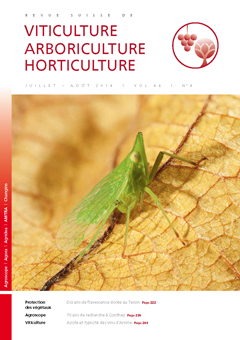
Issue 4 - July - August 2014
Abstract in open access
Dictyophara europaea has been recently considered an alternative vector of Flavescence dorée, an important grapevine phytoplasma. Unlike Scaphoideus titanus, known so far as the sole vector of this disease, its distribution and abundance in Switzerland, as well as its contamination level are unknown. A survey conducted in western and southern Switzerland in 2011 and 2012 showed that D. europaea is widespread and common in warm and dry ruderal sites close to viticultural areas. However, no insect could be captured in vineyards. Moreover, PCR analyses confirmed that none of the 248 individuals captured carried Flavescence dorée. Thus, D. europaea is probably not an important vector of Flavescence dorée and consequently does notrepresent a major threat to Swiss grapevine production.
Keywords: epidemiology, plantvector associations, insect vectors, phytoplasma disease, viticulture
E-Mail: christian.linder@agroscope.admin.ch
Adress: Agroscope, 1260 Changins/Nyon
Abstract in open access
Flavescence dorée (FD), a quarantine phytoplasma disease, appeared in Switzerland in 2004 in Ticinese vineyards, where it remains confined. Its spread throughout the territory has been constant. Overall, 37.4 % of all samples received were tested FD-positive. All told, 188 plots belonging to 161 producers were infected for the past ten years. In 13 % of the plots, FD was consistently diagnosed during a time interval of between four and ten years, despite its mandatory control. Ten years with FD have highlighted the complexity of the system and the need for a better understanding of variety sensitivity to FD, the potential role of alternative vectors and host plants, the ecological relationships involved and how the environment influences the different components of the system. This ten years experience underlines that a long-term coexistence is to be managed with this disease.
Keywords: Scaphoideus titanus, phytoplasma, grapevine, flavescence dorée, bois noir.
E-Mail: mauro.jermini@agroscope.admin.ch
Adress: Agroscope, 6593 Cadenazzo
Abstract in open access
An essay of partial grape drying on the vine, with pruning of the fruit branch some fifteen days before harvest, was made on the cultivar Diolinoir in the Agroscope research vineyard in Gudo (TI), from 2006 to 2010. Sugar content was improved with the technique of grape drying on the vine. The total acidity and the malic acid of the must were also higher in the dried grape. This drying technique was however linked to yield loss of 27 % in average. The polyphenols index, the anthocyanin as well as the wine color intensity were higher in the dried grape treatments. At testing, the wines resulting from the dried grape were systematically preferred to those issued from the control. The main differences were noticed in the structure, the intensity and the quality of the tannins.
Keywords: partial grape drying, red wine quality
E-Mail: vivian.zufferey@agroscope.admin.ch
Adress: Agroscope, 1009 Pully
Abstract in open access
An Agroscope trial conducted at Leytron (VS, Switzerland) lead to a high correlation between nitrogen supply, agronomical behaviour and quality of the wine of the grape variety Arvine. When the amount of available nitrogen in the grape juice is under 180–200 mg/l, the concentration of aromas precursors in the must and of aromas in the wine (3-mercaptohexanol) are notably lower. The wines are less typical, taste bitter, astringent and are less appreciated. In the case of severe nitrogen disorder, the photosynthetic activity of the leaves is reduced and must contents showed higher tartaric acid, lower malic acid and pH, and increased concentration in higher alcohols (2- + 3-méthyl-1- butanol et phényl-2-éthanol) in the wines.
Keywords: grapevine, nitrogen nutrition, Arvine, wine quality, thiols
E-Mail: jean-laurent.spring@agroscope.admin.ch
Adress: Agroscope, 1009 Pully

 Download of full issue
Download of full issue
 Download article
Download article